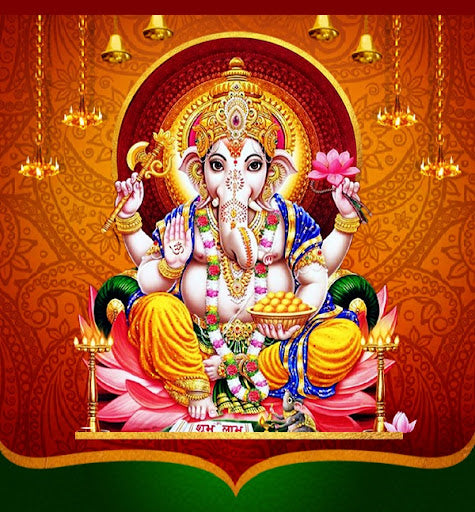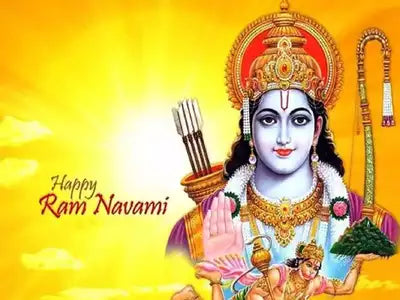Learn all about Ganesh
Ganesh, the beloved elephant-headed deity, is widely regarded as the beginning of all things in Hindu mythology. But why is that? To understand this, we must delve into the famous story of how Ganesh received his elephant's head, a tale that intricately connects him to the themes of creation, beginnings, and the removal of obstacles.
As the story goes, Ganesh's origin began when his mother, Parvati Devi, crafted a small boy from turmeric paste and breathed life into him. Parvati, seeking privacy for her daily bath, instructed her new creation to guard the door and not allow anyone inside. This boy, of course, was Ganesh, and as an obedient son, he took his mother's command very seriously. Unaware of who Lord Shiva, his father, was, Ganesh stood firm at the door, refusing entry to anyone — even Shiva himself.
Shiva, returning from his deep meditation, was understandably taken aback when he encountered this strange boy blocking his path. He demanded entry, but Ganesh, having never met his father before, was unmoved. The situation escalated rapidly, and in his frustration, Shiva lost his temper. Without further warning, he severed Ganesh’s head with a single strike.
The consequences of this action were swift and severe. When Parvati emerged from her bath and saw what had happened, she was devastated. A furious Parvati, distraught over the death of her son, threatened Shiva with catastrophic consequences. She declared that if Ganesh were not revived, she would unleash destruction on heaven and earth. This wasn’t an empty threat; Parvati, as a divine being, had the power to carry out her promises. Realizing the gravity of the situation, Shiva quickly set off on a mission to rectify his mistake.
In an attempt to restore Ganesh, Shiva instructed his followers to bring him the head of the first living creature they encountered. They returned with the head of an elephant, which Shiva, with his divine powers, attached to the lifeless body of Ganesh. The boy was brought back to life, but now, with the distinctive head of an elephant. This moment marked the creation of one of Hinduism's most beloved deities, who would go on to become the god of new beginnings, wisdom, and the remover of obstacles.
However, the story doesn’t end there. Parvati, still firm in her resolve, made an additional request. She insisted that Ganesh, now resurrected with the head of an elephant, would be worshipped first, before all other gods and goddesses, in any religious or spiritual practice. This decree was not just symbolic; it was deeply significant. Ganesh, with his elephant’s head, would become the deity to be called upon at the start of any venture, endeavor, or journey, ensuring that obstacles would be removed and success would follow. From that moment on, Ganesh would be honored as the remover of obstacles, a deity whose blessing would ensure the smooth completion of all endeavors, both material and spiritual.
The symbolism behind Ganesh’s appearance and the reason he is the "beginning of all things" can be understood on several levels. First, his elephant head, which is uniquely large and powerful, represents strength and wisdom. Elephants, in many cultures, are considered symbols of good fortune, intelligence, and memory. The fact that Ganesh is the god who removes obstacles, or "Vighneshvara," ties directly into his elephantine traits. Just as an elephant’s large body can gently push aside obstacles in its path, Ganesh is seen as the divine force that removes hurdles and clears the way for success.
Furthermore, Ganesh’s connection to new beginnings and the start of any endeavor is especially poignant. His role as the deity to be worshipped first in any undertaking speaks to his power over the transition from the old to the new. Whether one is embarking on a new job, a new business, or even a new chapter in life, it is Ganesh who must be invoked to ensure that the path is cleared of obstacles and that divine blessings are bestowed. In this sense, he is the god who symbolizes renewal, transformation, and the opening of doors to fresh opportunities.
Ganesh’s backstory involving his resurrection also highlights themes of rebirth and the cyclical nature of life. In many ways, Ganesh's life story mirrors the larger cosmic order — the creation, destruction, and recreation of the universe itself. Through the story of his decapitation and revival, Ganesh exemplifies the constant cycle of death and rebirth, of endings leading to new beginnings. This connection between life’s inevitable obstacles and the possibility for renewal makes Ganesh a universal symbol for overcoming hardship and transforming adversity into opportunity.
Ganesh’s association with wisdom, intellect, and learning further solidifies his role as the beginning of all things. As the god who facilitates the removal of obstacles, Ganesh is not only concerned with physical hindrances but also with mental and emotional challenges. Students, scholars, and artists alike invoke Ganesh’s blessings before starting any intellectual or creative pursuit. In this way, Ganesh becomes not only a protector but also a source of guidance, ensuring that the minds and hearts of his devotees are free from confusion and doubt as they begin new ventures.
Ganesh’s distinctive attributes further reinforce his role as the guardian of beginnings. His large ears symbolize attentiveness and the ability to listen to prayers, while his small eyes represent concentration and focus. His trunk, capable of both delicate and powerful movements, illustrates adaptability, a key quality needed to navigate life’s complexities. His potbelly signifies contentment and the capacity to digest both the good and the bad in life, a metaphor for resilience and balance.
In essence, Ganesh is not only the "beginning of all things" because of his unique origin but also because of his ability to clear the path for new beginnings. He is the god who stands at the threshold of every new phase in life, offering protection, wisdom, and support as people navigate the uncertainties of the unknown. His elephant head and his role as the remover of obstacles make him the perfect deity to turn to when embarking on any journey, whether spiritual, professional, or personal.
Thus, the story of Ganesh, from his creation by Parvati to his head being replaced by an elephant's, is not merely a tale of divine intervention. It is a profound reflection on the power of beginnings, the wisdom to overcome obstacles, and the enduring presence of divine support at the start of every venture. Whether in times of hope or despair, it is Ganesh who reminds us that every new beginning is an opportunity for growth, transformation, and success.
https://www.twinkl.com/teaching-wiki/lord-ganesh
https://gujaratikoalamom.com/blogs/history-about-holi/history-about-holika-holi-significances






